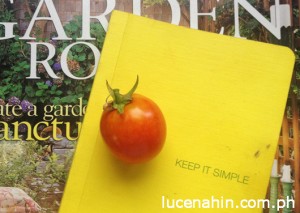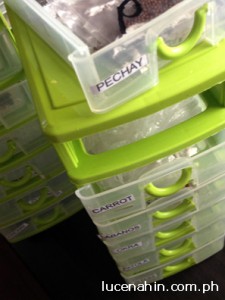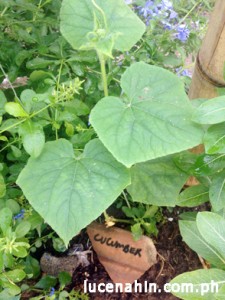How to start a Small Vegetable Garden in Lucena City
Have you ever wanted to grow your own vegetable garden? And you didn’t know where to start so somehow you just don’t follow through? It also doesn’t help that most search results in the internet are about growing plants in areas with 4 seasons when we generally only have two.
Well, getting started now just got easier by following our guide to starting a small vegetable garden here in Lucena.
 Step 1. Prepare a garden journal. This can be a small pocket sized notebook or a big sketchbook. Get in the habit of writing things down about your garden – name of plants, date of planting/harvesting and other observations you have. Taking notes of your successes and failures will help you understand your garden better. You can also include planting guides and sketches of your garden map and plans.
Step 1. Prepare a garden journal. This can be a small pocket sized notebook or a big sketchbook. Get in the habit of writing things down about your garden – name of plants, date of planting/harvesting and other observations you have. Taking notes of your successes and failures will help you understand your garden better. You can also include planting guides and sketches of your garden map and plans.
Step 2. Pick a garden location. Water should easily be accessible from the garden. Take note of the amount of sunlight it gets during the day.
Step 3. Buy basic gardening tools. You can start with a garden trowel, pruning shears and a shovel. Pick the sturdiest you can find so they will last longer. If you prefer container gardening, choose the largest pots that can fit your garden. This will hold more nutrients and moisture for your plants, so less maintenance for you. Make sure the pots have adequate drainage. Some decorative pots retain water which is not good for your plants. You can purchase these in any hardware stores in malls, near palengke or at CitiHardware in Iyam.
Step 4. Prepare your soil and start composting. You can get the soil in your garden tested for free by requesting it from the Office of the Provincial Agriculturist (OPA) near Perez Park. You can buy garden soil and fertilizers from garden shops but you can also just start with what you have and improve the soil by adding compost regularly and by mulching. The first few harvests may not be the best, but succeeding harvests continuously improve every time. It’s also best to start small and go bigger as you learn more about gardening.
 Step 5. Acquire seeds. You can get free seeds (and seedlings) from the City Agriculturist Office in Brgy. Isabang. We got kangkong and mustard seeds when we visited. You can also purchase seeds in several stores along Merchan St. near palengke. We purchased ours at Rivere’s Feed Supply where you can find cucumber, sitao, carrots, pechay, patola and the like. You can also purchase seed packets in grocery stores and some farms. You can also dry the seeds of your tomatoes and sili for starters.
Step 5. Acquire seeds. You can get free seeds (and seedlings) from the City Agriculturist Office in Brgy. Isabang. We got kangkong and mustard seeds when we visited. You can also purchase seeds in several stores along Merchan St. near palengke. We purchased ours at Rivere’s Feed Supply where you can find cucumber, sitao, carrots, pechay, patola and the like. You can also purchase seed packets in grocery stores and some farms. You can also dry the seeds of your tomatoes and sili for starters.
Step 6. Sow your seeds – some in seedling trays for transplanting later and others directly to the ground. Follow the instructions in the seed packets or research over the internet. We planted most of our crops directly to the ground.
There are many procedures that can help you with your crops, like companion planting. But I think it’s okay to learn these things a little later so you can just focus on getting started. It took me lots of time researching this when I really should’ve just planted where I like them and adjust accordingly. I planted sweet basils near my tomatoes, only to find something ate all basil plants a few days after. If a certain crop didn’t work, take note of it and just plant something else. When your soil gets healthier and you have more biodiversity in the garden, you’ll find places where you can plant them like I do now.
Where ever you decide to plant your seeds, just keep the soil moist and avoid placing seedling trays under direct sunlight for too long.
S tep 7. Add garden features like water dish or bird baths to attract birds and insects to your new garden. You also need to plant flowers (yellow ones particularly) to attract many pollinating bees, insects and birds. We need them – here’s a list of crops pollinated by bees, for example. You will also need plant markers so you can easily identify the plants in your garden. We used broken clay pots that we found lying around.
tep 7. Add garden features like water dish or bird baths to attract birds and insects to your new garden. You also need to plant flowers (yellow ones particularly) to attract many pollinating bees, insects and birds. We need them – here’s a list of crops pollinated by bees, for example. You will also need plant markers so you can easily identify the plants in your garden. We used broken clay pots that we found lying around.
Step 8. Water your plants regularly, add compost and record your observations. You’ll find that it’s easier to plant during the start of our rainy season, but you can start your garden anytime. Also look out for pests that might destroy your crops.
Step 9. Read, Research and Apply. You can learn more about the crops that you planted as well as many gardening techniques through books, blogs, videos and online forums. If you like how a cottage garden looks, permaculture might also interest you too. You can also get help by dropping by at the City and Provincial Agriculturist Offices, the first located in Isabang and the latter near Perez Park.
You don’t have to do all things at once, but I would like to invite you to try going organic. Try things out one by one and hopefully, you will be able to harvest fresh vegetables from your garden soon enough. Freshly picked organic vegetables have a somewhat sweeter and in some, crunchy taste to them that you will love.

 Philippine Peso
Philippine Peso